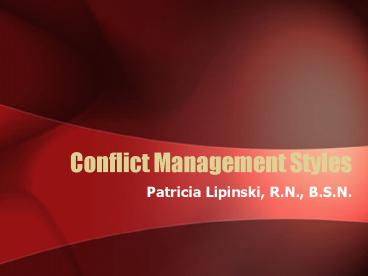Conflict Management Styles - PowerPoint PPT Presentation
1 / 18
Title:
Conflict Management Styles
Description:
Can include a willingness to understand. May have an attitude of ... Potential damage of confronting conflict outweighs the benefit of resolution. Compromise ... – PowerPoint PPT presentation
Number of Views:669
Avg rating:3.0/5.0
Title: Conflict Management Styles
1
Conflict Management Styles
- Patricia Lipinski, R.N., B.S.N.
2
Styles
- Competition
- Accommodation
- Avoidance
- Compromise
- Collaboration
3
Competition
- Adversarial style
- Focuses on your perspective
- Can include a willingness to understand
- May have an attitude of respect for others
- Winner takes all win-lose situation
4
Dominant Style
- Focus on task or goals and well organized
- Committed to your own perspective
- Expect others to come forward with their
viewpoint - Fear loss of control when undermined/overtaken
- Focus on what you want
- Defending your own position
5
When to Use Competition
- Respond quickly and decisively
- When delivering an unpopular decision
- To protect yourself from those who would take
advantage of a cooperative approach
6
Accommodation
- Focuses on the needs of others
- Behaviors range from quick capitulation to a
willingness to give in after exploration - Adversarial tone created by seeming to agree but
then displaying other behaviors - Giving in results in lose-win situation
7
Dominant Style
- Are non-competitive
- Flexible, tolerant and harmonizing
- Neglect your concerns to satisfy concerns of
others - Self-sacrificing
- More concerned with being liked and getting along
than being right - Do more than your share
8
When to Use Accommodation
- Realize your wrong and want to be open
- Goodwill gesture - issue is important to others
- Preserving the relationship is more important
9
Avoidance
- Focuses you away from conflict
- Includes
- Belligerent unwillingness to talk
- Hesitation to discuss issues
- Attempt to smooth things over when differences
appear - Lose-lose approach
10
Dominant style
- Appear to ignore conflict situations
- Dont pursue your concerns or those of others
- Back away from conflict situations
- Postpone conflict
- Believe in time conflict will go away
- Anxious when confronted with conflict
11
When to Use Avoidance
- Need time to gather facts or think about
situation - Allow emotions to cool down
- Perceive there is no chance to satisfy your
concerns - Potential damage of confronting conflict
outweighs the benefit of resolution
12
Compromise
- Focuses on trying to satisfy both parties
- May result in surface solutions
- Does not get to heart of the matter
- Range from positional stances to more flexible
approaches - Win/lose and win/lose situation for both sides
13
Dominant Style
- Search for expedient, mutually acceptable
solutions - Prefer quick and practical resolutions to issues
- Believe if both parties give something up, it is
fair to both
14
When to Use Compromise
- Goals of both parties are moderately important
but not worth pushing too hard to achieve - Provide a temporary solution
- Expedites a solution when under pressure
- When two parties of equal power are committed to
achieving a mutually exclusive goals
15
Collaboration
- Focuses on satisfying both parties
- Cooperative in nature
- Both parties tend to persist when there is
chance of success - Often a slow process
- Not appropriate
- in all cases
- Win/win situation
16
Dominate Style
- Are non-avoiding
- Identify concerns of both parties and find
alternatives - Curious about others underlying motives and
needs - Open to exchange insights and work toward
creative solutions - Believe outcomes of negotiation will be best
solution
17
When to Use Collaboration
- Objective is to learn more about the other party
- Provide a creative solution to both sets of
needs, concerns - Both parties are committed to merging both views
and - interests
18
Nurse Processes Conflict
- Disbelief
- Disconnectedness
- Obsession with situation
- Frenzied activity
- Self evaluation
- Crucial turning point
- Balance or burnout
- Purposeful alienation































